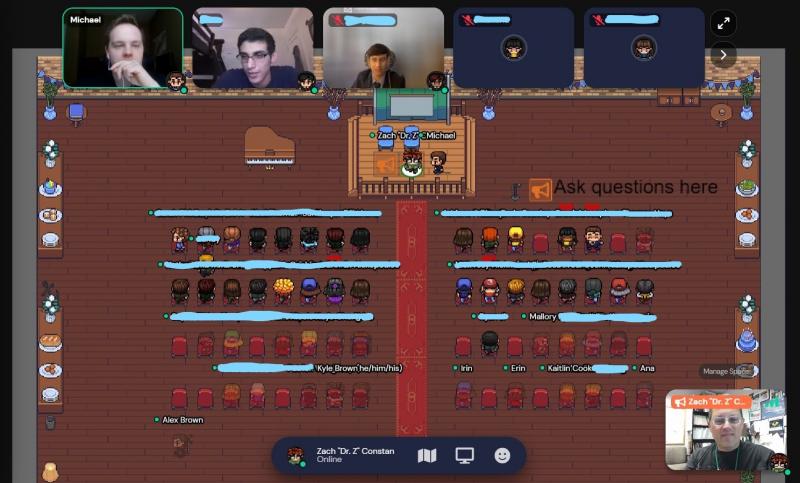Data
You will be redirected to cenamweb.org in 15 second(s). The JINA-CEE website is not updated anymore. The archived website can still be reached through the CeNAM website.
Physics of Atomic Nuclei (PAN) 2021

The 28th annual Physics of Atomic Nuclei (PAN) program ran during the week of July 26-30. This year’s program marked the second time PAN was conducted online. The goals were unchanged: to give motivated high school students an authentic research experience while connecting them to current scientists and an insider view of academia. For this year, organizers continued to develop the online framework of lessons and activities using GatherTown to achieve an online experience that facilitates interaction and communication.

Once again, the online program was able to draw 30+ volunteers from a wide variety of JINA institutions and partners: Michigan State University, University of Notre Dame, Ohio University, Central Michigan University, Western Michigan University, Grand Valley State University, Rutgers University, Gonzaga University, and University of Wisconsin. These volunteers mostly aided in creating and running four different research projects, each involving modeling or computational techniques that relate to current nuclear astrophysics. A faculty member at Michigan State University offered a tool to let students predict “magic numbers” and the thickness of a neutron skin. Another experiment was facilitated by collaborators at University of Victoria, who developed code for modeling element synthesis in stars that the students could employ while seeking most critical nuclear reactions for further study.
With a robust volunteer turnout and the lack of logistical costs (housing, etc.), PAN was again able to host 36 students compared to the usual 24. Student teams chose one of the experiments to pursue throughout the week, working alongside a JINA mentor and overseen by the faculty who developed the project. Friday saw the culmination of those projects in the poster session where each group communicated their results. PAN online included more social interaction this year with the addition of a “Lunchroom” and games “Lounge” where students and scientists could meet in the Gather space.
Post-survey data indicates that PAN 2021, while online, had a very similar impact as the in-person programs of previous years. Students commonly expressed these lessons learned:
- Research isn’t “just for adults with a four-year degree”
- Collaboration is critical to research at the frontier
- For those who hadn’t considered physics and/or nuclear astrophysics for their college major and/or career, PAN increased their interest in that path
- For those who were previously interested in a physics career, PAN further inspired them to pursue their dream
Students, organizers, and volunteers were very pleased with the program overall. In the words of one student:
“PAN has opened my eyes to the endless possibilities that come with a science degree/career. Before, I was set on working in a specific field, but now I know to keep my options open because there are many options I can explore. It has also helped me realize that you don't have to be a genius to be a good scientist. You need to be dedicated, confident, open-minded, and educated... I may not be ready yet, but I am confident that I will be.”
More details on the “hands-off” experiments completed at PAN Online:
- Creating the Isotopes: using modeling code they could run on their own laptops, students could select any isotope and generate the energies and quantum numbers associated with the motion of one proton or neutron in the presence of all other nucleons in that nucleus. The resulting level schemes and emergent patterns helped them understand stability, magic numbers, beta decay, the location of the proton and neutron drip lines, and the nuclear "spin". All of these are important for understanding the role that each isotope plays in astrophysics.
- Rutherford Scattering: students calculated the probability of Rutherford scattering in a given collision, recalling the earliest nuclear experiments. They first calculated and then measured the number of atoms in a very thin metal foil that was used for a recent experiment, and also used Rutherford scattering to look for elemental impurities in the foil. Students reproduced the method used to confirm that the nuclei of atoms were far smaller than the atom itself, and explored how scattering first revealed the elemental composition of moon rocks.
- Nucleosynthesis: computer modelling code allowed students to predict the elements that are created in different astrophysical scenarios, and then tweak the reaction rates to identify some of the important nuclear reactions that are responsible. This was made possible by the Astrohub online virtual research environment (https://astrohub.uvic.ca), developed and operated in a JINA-CEE collaboration by the Computational Stellar Astrophysics group (http://csa.phys.uvic.ca) at the University of Victoria and hosted on the Computed Canada Arbutus Cloud at the University of Victoria.
- Nuclear Decay: students examined the nature of nuclear decay through the natural decay chains of the heaviest elements, then analyzed data from separated isotopes to measure half-lives and examine the parent/daughter relationships in the uranium decay chain. Students also investigated how to use long-lived nuclei as a clock for geological cycles and archeology. This research project exposed participants to different types of nuclear decays, kinetics, and detectors.
PAN2021 was jointly organized and sponsored by JINA-CEE and the NSCL
